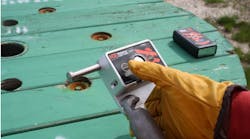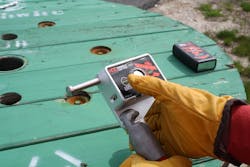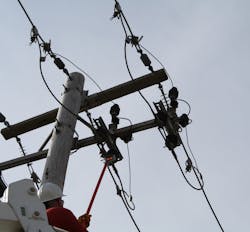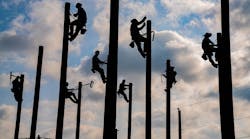With 200,000 miles of transmission lines and 5.5 million miles of local distribution lines the US power grid has become “the largest interconnected machine on Earth”. For over a hundred years the US electric power industry has been adopting new technologies and methods as they become available, often from other industries. During the last several decades, the availability of rugged power electronics, distributed computing and secure communications has led to all sorts of “smart” devices – so much so that the term Smart Grid is in common use.
Ironically, with so much attention given to hi-tech development it’s sometimes been easy to neglect the needs of powerline workers - those hardy men and women who keep the lights on during storms, floods, and other calamities. And when a driver takes out a power pole or when fuses need replacing after an insulator flashover, we depend on the folks in the hard-hats - and the ‘simple’ tools in their hands. But the tools and equipment are becoming ‘smarter’ and more effective, workers are becoming more efficient and staying safer.
As a case study, let’s consider the FireFly® multipurpose hot stick tool developed by HD Electric in cooperation with Commonwealth Edison (ComEd).
The Challenge
“This isn’t the first time we’ve called on HD Electric to help develop a practical solution to an ongoing need,” said Ed Bengson, Methods Manager at ComEd in Chicago, “They’ve got a top technical staff and the flexibility to work with us on a wide range of equipment sizes and complexity.”
As Methods Manager for ComEd, Bengson is responsible for powerline tools and methodology. As such, he gets the ‘privilege’ of hearing firsthand the complaints, suggestions and sometimes cheers from the front lines. “They don’t hold back,” he adds, “Those linemen will let you have it if they’re not getting the right support.”
The FireFly® case had to be small, light and tough
From long experience working with hot-line projects in a variety of conditions, Bengson intimately knew the need for a one-piece hot stick tool for distribution line work. It would need: 1) a conventional fuse/air switch prong, 2) voltage detection that could identify a live line with both an audible and visible alarm, 3) a high intensity light source that would illuminate the work area without ‘blinding’ the worker on the ground or in the bucket. And, by the way, it had to be small enough to get into tight pole-top spaces and light weight enough to be manageable at the end of a 35-foot hot stick!
But what would justify the development of such a device? Again Bengson: “A lot of the payback would come through the safety of the new features, preventing the possible severe injury while working in adverse weather conditions. Imagine using three different tools on the end of a thirty-plus foot long hot stick on the ground.”
“Essentially,” grins Ed, “we’re looking for the Swiss army knife of hot stick tools!”
Could HD Electric Do the Job?
Hot sticks are deceptively simple devices. The first hot sticks appeared around 1913. They were often home-crafted, made from oven-baked dry wood, by the workers themselves. Understandably, those early line workers were cautious, even afraid, of lines that were supposed to be de-energized but sometimes weren’t. Hot sticks, homemade or otherwise, were life savers.
As the public came more to rely on electricity, outages for construction and repair became less tolerated and utilities were pushed towards even more “hot-line” work. By the early thirties hot-line work had become routine and hot sticks were being manufactured by several companies. The hot stick had become known as the lineman’s “best friend”.
Even after a century, though now usually made of fiberglass with water-repellent coating, hot sticks are functionally the same: poles of various lengths with a wide spectrum of available tools to attach at the “hot” end.
But nobody had developed anything like the multipurpose tool that ComEd wanted.
“I told Ed that I was sure we could develop and manufacture what he wanted,” remembers Bill McNulty, Technical Director at HD Electric Company. “But I realized right away that this wasn’t going to be an easy task. We were going to need compact voltage sensing electronics that could withstand the harsh electrical environment surrounding energized lines. We would need ‘smart’ illumination circuitry that would not only put the light in the right area, but would maintain the same brightness during emergency conditions when a battery change-out wasn’t possible.”
HD Electric already has extensive experience in electrical field detecting with their line of self-contained voltage detectors that were well proven in the utility industry. So, the basic detector circuitry was available, but it would have to be repackaged.
Besides electrical stresses, the tool would also be subject to rain, temperature extremes, and the impacts of being dropped from an elevated bucket or tossed into the back of a line truck. All the types of treatment that imperil electronics. Circuit boards can crack and battery connections jar loose.
Then there was the matter of the case form factor - the shape and size of the tool. It needed to be small and it had to be as light as possible. That meant cast or milled aluminum. Cast housings were cheaper, but a milled aluminum design could be produced from models generated by a 3-D printer.
Development Begins
The first step was to field test a trial case design. “A preliminary aluminum case, milled from the 3-D printer design, was given to ComEd. We asked Ed to have his people do their worst – and they did!” smiles Bill.
Could aluminum withstand some of the physical forces that the tool would experience when used as a fuse tool and to open switches?
“The answer is no, it could not,” says McNulty. “During harsh midwestern winters, sometimes these switches freeze up and a line worker has to apply his full weight to open the switch. Early tests showed that the aluminum nose of the tool, the disconnect prong, could sometimes break.”
So, steel was chosen for the nose. The change didn’t add much to the weight - the unit (even when full of circuitry) still weighs only one pound!
Next came the internal circuitry design.
“We’re fortunate enough to have some really bright engineers that are well trained in a variety of hi-tech areas,” says Bill proudly, “One of them is Michael Standiford.”
Michael is a graduate in electrical and electronics engineering from Purdue University where he specialized in microprocessors and other types of electronic circuit design. When asked why he moved from millivolts to kilovolts, Michael just laughs. “There are so many opportunities to apply low voltage solutions to high voltage issues.”
As an example, consider the control of the illumination circuitry. “Sounds easy, but we’re not just talking about a flashlight taped to a hot stick!” Standiford quips.
No Short Cuts
As a safety measure, the battery power supply had to be separate from that of the voltage sensing circuitry. But also, for worker safety, the illuminating white LED lights needed to maintain a constant brightness even as the batteries were discharged. A special LED power supply design solved the issue.
Then through field trials, it was discovered that the separate voltage-sensing red LED light was too bright at night and interfered with the worker’s vision. That problem was solved by adding circuitry that dimmed the alarm at a determined level of darkness.
Of course, ComEd also required the device to be field serviceable, using batteries that were in common use by crews and kept in the line truck supplies.
Lots of debugging, lots of solutions. And for engineers like Michael, a lot of satisfaction and sometimes fun!
Bill and others on the FireFly tool design team also know a thing or two about the physics of electric fields and were able to resolve some design challenges with the voltage detection plate and case interface. “There’s no room for error here,” emphasizes Bill, “we’re dealing with worker safety! Even though we’re using well-proven technology for high voltage proximity detection, we had to make sure we could get high sensitivity with the new housing. And we did!”
A Surprise!
The HD Electric team’s knowledge of high voltage electric fields also came into play in resolving an unforeseen development issue:
Bare aluminum will eventually corrode with exposure to harsh outdoor conditions. To prevent corrosion, the first FireFly tool’s aluminum cases were anodized, producing a hard, protective coating of aluminum oxide. However, the interface between the coating and aluminum always contains some microscopic gaps. When placed in a high electric field, such as one surrounding an energized conductor, the gaps form tiny micro-arcs. These in turn produce high frequency electrical “noise”, or RFI, that can interfere with sensitive circuitry.
This was something new, not reported in the engineering literature.
After looking at alternatives, Michael and others on the team decided to go with nickel plating. The case was again tested under extreme voltage conditions. Fortunately, HD Electric has a high voltage laboratory capable of testing equipment at up to 100kV.
Results? No micro-arcs, no electrical noise, no problem! Issue resolved.
The FireFly® is small enough to get into tight spaces…
FireFly Takes Off!
ComEd has been thoroughly field testing the units and gathering feedback and suggestions from the harshest critics - the line workers themselves. The consensus is – they love it! The combination tool does what it’s supposed to do, saving time, boosting efficiency and increasing worker safety.
And HD Electric continues its mission. There are FireFly models for various distribution voltage ranges. And who can say what other clever hot stick tools and line equipment will be requested by HD Electric client utilities?
Bill McNulty again: “Our project development almost always originates from a customer’s request. And we do our very best to iron out any technical issues before we send out products to be thoroughly field tested by our customers prior to release to the market. We have the brightest people, trained in the right areas. And we have the best testing methods and laboratories.”
The success of the FireFly tool development illustrates the strength of this approach.
…and light weight enough to use with the longest hot sticks!
Just the Beginning!
About half of US powerline workers will reach retirement age during this decade. We’ll have increasing work-force shortages along with new, inexperienced men and women who need the best support the industry can offer. And, of course, safety is always a concern - power line workers are in one of the top ten most dangerous professions.
That’s why hi-tech improvements to line worker safety and work efficiency are needed more than ever. The Textron companies - HD Electric Company, Sherman + Reilly, and Greenlee - are working hand in hand with leading utilities to help lead the way.





